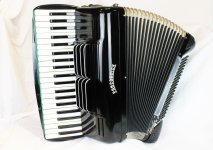- Joined
- Apr 30, 2013
- Messages
- 5,178
- Reaction score
- 990
This tread is of history of models of USmade PANcordions & Italian made PANcordions ( Crucianelli) . The information here might just be of interest
to members unfamiliar to the design & history of the models of PANcordion. Some of the history here has appeared in print and some is from
knowledgeable word of mouth. My word of mouth knowledge stems from my visits to Ernest Deffner Inc. of New York City. Ernest Deffner was the
owner & the US distributor of the Titano & PANcordion brands. In the late 60's I was working full time for Falcetti Music a Titano dealer and back in the
time it was more economical to drive to NYC than having accordions shipped. Back in the day the trip only took a little less than 3 hours ( 3 1/2+ hours
today) and gas was inexpensive (5 gal. for $1.00). This visits would last for a day trying models of Titanos and PANcordions. The late Emil Baldoni
(my first mentor) was head of the repair Dept. and an absolute wealth of information not found in print today. Deffner already a distributor of brass
& wood instruments joined forces with Robert Pancotti in the late 40's. Robert Pancotti Had left his family owned Excelsior Accordion Co. to
develop & patent a series of accordion innovations which were profound at the time. They founded the firm PANcordion Inc. and purchased the old
Wurllitzer accordion factory in Long Island, NY. Here they built hand made accordions that featured the innovation "Directone" a patented design
that was and is unique as it carries 30% more carrying power to the accordion. There was no need for a model with Cassoto as the accordion body
itself was and is a tone chamber. They featured those elongated shifts affording access to tone changes from any keyboard playing position.
These PANcordions were favored by professional accordionist such as Lawence Welk, Myron Floren, & Frankie Yankovic to name a few.
This new PANcordion factory had more than 40 craftsmen building hand made accordions in the late 40's & thru the 50's. Among some of the
craftsmen were John & Angelo Magnante (brothers of Charles Magnante) , Natale Frosini ( Pietro Frosini's brother), to name a few.
In the 60's as with all the US accordion firms it was found economically necessary to develop an Italian made line of their models. Deffner chose
the firm of Sante Crucianelli to set up production for the US market. The now closed Crucianelli factory at the time produced models of now late
PANcordion, PANitailia,, Crucianelli, & Video. All models of excellent build.
And just a note Crucianelli labeled some of their own designs PAN's such as the Batton Tone Chamber but it was not a "Directone" design.
to members unfamiliar to the design & history of the models of PANcordion. Some of the history here has appeared in print and some is from
knowledgeable word of mouth. My word of mouth knowledge stems from my visits to Ernest Deffner Inc. of New York City. Ernest Deffner was the
owner & the US distributor of the Titano & PANcordion brands. In the late 60's I was working full time for Falcetti Music a Titano dealer and back in the
time it was more economical to drive to NYC than having accordions shipped. Back in the day the trip only took a little less than 3 hours ( 3 1/2+ hours
today) and gas was inexpensive (5 gal. for $1.00). This visits would last for a day trying models of Titanos and PANcordions. The late Emil Baldoni
(my first mentor) was head of the repair Dept. and an absolute wealth of information not found in print today. Deffner already a distributor of brass
& wood instruments joined forces with Robert Pancotti in the late 40's. Robert Pancotti Had left his family owned Excelsior Accordion Co. to
develop & patent a series of accordion innovations which were profound at the time. They founded the firm PANcordion Inc. and purchased the old
Wurllitzer accordion factory in Long Island, NY. Here they built hand made accordions that featured the innovation "Directone" a patented design
that was and is unique as it carries 30% more carrying power to the accordion. There was no need for a model with Cassoto as the accordion body
itself was and is a tone chamber. They featured those elongated shifts affording access to tone changes from any keyboard playing position.
These PANcordions were favored by professional accordionist such as Lawence Welk, Myron Floren, & Frankie Yankovic to name a few.
This new PANcordion factory had more than 40 craftsmen building hand made accordions in the late 40's & thru the 50's. Among some of the
craftsmen were John & Angelo Magnante (brothers of Charles Magnante) , Natale Frosini ( Pietro Frosini's brother), to name a few.
In the 60's as with all the US accordion firms it was found economically necessary to develop an Italian made line of their models. Deffner chose
the firm of Sante Crucianelli to set up production for the US market. The now closed Crucianelli factory at the time produced models of now late
PANcordion, PANitailia,, Crucianelli, & Video. All models of excellent build.
And just a note Crucianelli labeled some of their own designs PAN's such as the Batton Tone Chamber but it was not a "Directone" design.
Last edited:

